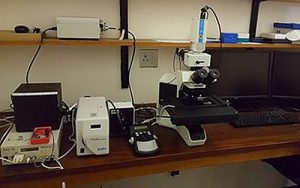Nano and Microparticle Toxicity Unit
This unit is involved in the assessment of hazard and exposure of engineered and incidental nano- and microparticles. The Unit makes use of specialized techniques and cutting-edge equipment for cytotoxicity testing of particles, including assessment of uptake as well as the measurement of exposure through a range of particle sizing instruments.
Hazard Identification
In vitro toxicity assays performed by this unit include:
- Cytotoxicity Assays
- Cell Impedance toxicity assessment using the xCELLigence RTCA system
Oxidative Stress Assays:
- 8-hydroxy-2-deoxyguanine
- lipid peroxidation
- Nitric Oxide production
- oxidative burst
- ability to produce reactive oxygen species
Exposure Assessment

The CytoViva HSI system with upgraded 3-D capabilities, housed in the Toxicology and Biochemistry Section at NIOH
The CytoViva Hyperspectral Imaging System (HSI) is extensively used in the department to investigate the uptake of micro- and nanoparticles. CytoViva Imaging Technology provides optical imaging of nanomaterials and biologicals, as well as spectral imaging analysis of nanomaterials and cellular features. CytoViva’s patented illumination technology integrates onto a standard optical microscope, creating a high signal-to-noise, darkfield-based image. This specialized capability enables fast observation of a wide range of nanomaterials and pathogens along with unlabeled or fluorescently labeled cells and tissue. The CytoViva Microscope system is then combined with the CytoViva HSI, which enables the analysis of spectral data from these images. The HSI operates in the visible and near infrared spectral range (400-1000nm) and has been specifically designed to support nanoscale studies. Recently this instrument has been upgraded to a 3-D system which makes use of the imaging capability of the current CytoViva system to create three dimensional representations of nano-scale objects, enabling on to determine the exact location of the investigated particles within tissues and even organelles within the cells.
The Toxicology Section contains a range of particle sizing instruments including a Scanning Mobility Particle Sizer (SMPS), Condensation Particle Counter (CPC) Model 3772 and an Aerodynamic Particle Sizer (APS) Model 3321. Together, the SMPS, CPC and APS can measure size distributions of ambient particles or powder dispersions from 7 nm to 20 µm. The Section also has mobile instruments equivalent to the SMPS and APS mentioned above, namely, the NanoScan SMPS Model 3910 and the Optical Particle Sizer (OPS) Model 3330, which, when combined, can measure particle size ranges between 10 nm and 30 µm. The Section has also recently acquired a Partector-TEM portable aerosol dosimeter, which can measure the alveolar lung deposited surface area (LDSA) of ambient particles from 10 nm to 10 µm in the breathing zone of an individual. In addition, the Partector-TEM allows for collection of particles on a TEM grid for off-line particle characterisation.
For more Information about the Nano and Microparticle Toxicity Unit, contact:
Head of Toxicology
Dr Natasha Sanabria
Tel: +27(0)11-712-6471
Email: natashas@nioh.ac.za
Head of Toxicology Research Projects
Prof Mary Gulumian
Tel: +27(0)11-712-6428
Email: maryg@nioh.ac.za
